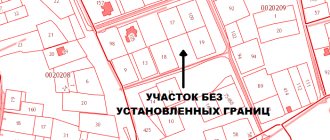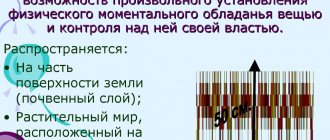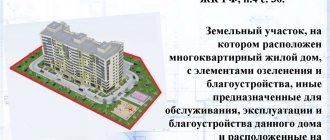An abandoned plot does not mean that it has no owner. Perhaps there is an owner, but for some reason he does not use the land. If an outsider begins to use a plot that has an owner, namely: erect buildings, carry out agricultural work, this will be considered unauthorized seizure. Administrative liability is imposed for such actions. Read the article about how to legalize unauthorized occupied land.
Land in our country is immovable property and for this reason it is possible to become the legal owner of a land plot only after registration of ownership rights. This is set out in the Land Code of the Russian Federation. In this regard, until the ownership of the land is properly registered, and the boundaries of the site are not determined, all manipulations with the land are illegal.
In other words: squatting is the use of someone else's land plot for one's own purposes, without having the legal right to do so. Such actions include: erection of buildings, cultivation of land for agricultural purposes. In this case, the use of the site occurs exclusively for personal purposes, and the seizure of the territory is on one’s own initiative.
Don’t think that only ordinary citizens engage in squatting by placing a vegetable garden in an abandoned neighboring dacha. In most cases, the law is violated by officials who have information about land plots. Having information about plots that are not in demand by the owners, land is seized.
If you encounter something like this, when an unknown person uses your land for personal purposes without having the right to do so, contact law enforcement agencies and the offender will be held accountable.
You can use land for personal needs in our country if one of several factors is present:
- property rights;
- lease agreement;
- easement;
- inheritance rights.
If the person using the land plot does not have any of the above documents, it can be assumed that he has appropriated the plot and is a violator of the law. These persons do not have the right to perform any actions with the land plot, namely: sell; rent out to third parties; make a will; alienate rights in other ways. If the person who has committed the seizure of someone else's territory is engaged in commercial activities on this land, the funds derived from this activity will be considered illegal income.
How to register the addition of a land plot in accordance with the Land Code
The Land Code does not contain such a concept - the addition of a land plot. Redistribution of land plots is commonly called redistribution. According to the general rules for the formation of land plots (Article 11.2 of the Land Code), there are several types of formation of new land plots:
- Allocation;
- An association;
- Redistribution;
- Chapter.
In the article we will not consider each of these types in detail, but we will talk in more detail about redistribution, or more precisely about how the addition of a land plot in 2021 occurs due to the area of adjacent lands, and how the size of a land plot can be legally increased.
Arbitrage practice
The Supreme Court clarified the rules for dividing land plots in cases that most often occur (during divorce, receiving an inheritance, etc.). In these situations, the size of land plots after the division process is of great importance. According to the law, the owner can receive his plot only if all the shares received after the division meet the established standards for the intended use. For example, dividing a garden plot can only be done if in the future all parts can be used for the same purpose.
Explanations of the correct division of land were given when the judicial panel for civil cases of the RF Armed Forces reviewed a land dispute that occurred on the territory of the Volgograd region. The essence of this case is as follows: a citizen decided through the court to obtain the allocation of part of a plot of land and a house, which were in common ownership of several people.
The plaintiff owned 2/3 of the land and home ownership, and the other 1/3 belonged to the woman. After the death of the owners, its part passed to the heir. According to the BTI passport, the area of the plot was 506 sq.m., and the house - 70.1 sq.m. This land was intended for horticultural purposes, therefore, when dividing it, it was necessary to comply with the permissible parameters for the continued use of the shares for the same purpose. However, the heir was not satisfied with such a division, and he filed a counterclaim against the plaintiff in order to divide the property according to his own version. But the court decided in favor of the plaintiff, giving him 337.3 sq.m. land, and the heir - 167.7 sq.m. The same decision was upheld on appeal.
When making such a decision, the Volgograd local court relied on ownership shares, but the Supreme Court did not agree with this. He explained his decision in Article 1. Land Code. It states that the division of plots owned by several people at once can be carried out using different methods. New plots can be allocated from existing ones or redistributed from existing plots, as well as sold or given away. The division of shares is also the allocation of a plot. At the same time, both the new and the remaining parts continue to be considered sections, but with new boundaries. The owner of the allocated share becomes the full owner of the individual plot, and the owners of the remaining parts of the plot remain the owners of shares of the common property. However, despite the methods of division, the original intended purpose of the land and all parts separated from it must be observed. The law also stipulates the maximum and minimum sizes of new plots.
In 1996, a plenum of the Supreme Arbitration and Supreme Courts was held, at which the Civil Code was discussed. Article 252 of the Civil Code of the Russian Federation states that the court may refuse to divide common property according to shares, if in this case all the resulting plots cannot continue to be used for their intended purpose. In this case, it is considered that the common property is damaged.
The Supreme Court clarified that the same thing is recorded in the Law “On the State Real Estate Cadastre”. It says that the cadastral authority may refuse to register a land plot if the divided shares do not correspond to the sizes specified in the law (minimum and maximum). Based on the above laws, the Judicial Collegium for Civil Cases comes to the conclusion that the allocation of a part of a land plot that is in common ownership is possible only if the intended use and permitted areas are observed during the division.
The Land Code states that the minimum and maximum sizes of plots can be established only by town planning regulations. And the Town Planning Code states that the size and rules of land use are established by local authorities. In the case discussed above, it was necessary to rely on the resolution of the Volga City Duma of the VO, according to which the maximum plot size can be 0.2 hectares, and the minimum - 0.02 hectares. That is, the part of the land allocated to the defendant with an area of 167.7 sq.m. does not comply with this resolution. This became the reason for the review of this land dispute by decree of the Supreme Court of the Russian Federation.
New law on land acquisition 2021
Laws in the field of land management and cadastre have undergone active changes in recent years. The new law on the addition of land plots, effective in 2021, is a whole layer of rules affecting the formation of land plots. At the beginning of 2019, Federal Law 217 on horticulture came into force, changing the basic concepts and definitions of summer cottages. On June 17, 2021, a new law 150-FZ was adopted, amending the laws on cadastral activities and real estate registration (218-FZ and 221-FZ). The changes concern complex cadastral works: the procedure for carrying them out is simplified, while it remains possible to increase the land plot up to 10% of its total area if, during the complex cadastral works, it turns out that in fact the plot is larger than on paper. The State Duma is also considering a number of amendments to simplify the procedure for registering land plots and buildings (the dacha amnesty will be extended until 2022).
Only the owner can add additional acres to his plot. Tenants of land plots, as well as persons who own land plots for free use, do not have this opportunity.
When registration is required, how much land can be added to your plot
The cut-off is legally called redistribution. This is possible in the following cases:
- Development Agreement. When this action (cutting) is determined by a previously concluded special agreement. Following it, it is necessary to adjust the boundaries of the existing plot where construction is taking place in accordance with the created boundary plan.
- To avoid wedging, interspersing, broken or interstriated existing boundaries. It is worth remembering that the area of the land property must be increased by more than the maximum size established by law. Sometimes trimming allows you to set boundaries better. Necessity determines land surveying. As you know, if the boundaries cannot be accurately identified and fixed, then subsequent registration of the allotment in Rosreestr will be difficult.
- You can annex land if... The existing plot has the following purpose: for private plots, individual housing construction, SNT, dacha farming, etc. Moreover, it must be remembered that the size of the plot, which is considered personal property, can only be increased to the limits established by law.
- Allotments are confiscated. According to 49 articles of the Land Code of the Russian Federation, territories nearby can be annexed to an existing site if the local administration plans to seize it for some state or municipal needs. For example, they are planning construction there.
Sanctions for illegal land seizure
Cases of illegal seizure of land are established by Art. 7.1 Code of Administrative Offences. If fraudulent aspects are identified, the case may fall under the criminal code. With this option, the offense faces much more serious consequences than just a fine and seizure of the site. In the absence of fraudulent activity, the violator will most likely pay a fine. Its size depends on several factors:
- whether the plot is registered in the cadastral register;
- What is the estimated value of this plot of land?
How much land can be annexed
Many people are concerned about how exactly the redistribution procedure occurs. Does a person simply select the desired amount and “cut off”? No, the RF Land Code specifically states how much land can be added to the main plot. If the maximum quantity specified there is exceeded, then such an object cannot be registered.
Simply put, the plot being cut, in principle, should not be larger in size than the area where it is being cut. Most often it is 5-6 acres. However, each region sets the maximum size independently. It is necessary to clarify the information with Rosreestr or the cadastral organization.
How to legalize the addition of a plot of land for free
Attaching a land plot to the main one is an increase in the size of the land plot at the expense of adjacent lands. Not every owner is aware that he can legally register an addition to a land plot and receive additional land ownership free of charge. How to legalize the cutting of a plot of land for free, you ask? In fact, the law allows the increase of a land plot by no more than 10% of its area at the expense of municipal lands. But there are also caveats. It is important that the land is not privately owned and under encumbrances; in addition, local authorities have the right to legally establish additional restrictions on the size of the addition of land plots. In any case, the registration of the addition of a land plot should be legalized by submitting the necessary documents to the Rosreestr authorities.
What is a cut-in?
An increase in land allotment is considered to be the expansion of the boundaries of the existing territory at the expense of unauthorized annexed lands that are located nearby. Since the number of unauthorized plots was increasing, the government decided to legalize and regulate the cutting process.
To regulate the processes of land cutting, the Government of the Russian Federation introduced amendments to the Land Code, which came into force on March 1, 2015. As a result, Chapter V.4 appeared in the Land Code, regulating the acquisition of land , which was renamed the redistribution of territories, and allowing the legalization of unauthorized occupied plots . Therefore, the concept of redistribution of land plots is the addition of an allotment on a legal basis.
After March 1, 2015, a citizen who owns a plot of land that is intended for performing activities related to vegetable gardening, horticulture, agricultural activities, and individual construction can apply to the Authorized Body (AU) for the redistribution of municipal land. The redistribution procedure under the new legislation is carried out in accordance with Chapter V.4, Art. 39.29 ZK .
Procedure for registration of cutting
When adding land to a site, the procedure is as follows:
- Writing an application. You can view and download here: [ sample application for land acquisition]. This document is the basis for starting the process of cutting off a plot and concluding an agreement for the redistribution of land. The application states (clause 2, article 39.29 of the Land Code):
- passport data (document number, place of registration, full name) of the applicant-citizen or name, INN and registration number in the Unified State Register of Legal Entities for the applicant legal entity. faces;
- cadastral numbers of land plots that will participate in the cutting process;
- details of the project for land surveying (if the cutting will be carried out in accordance with it);
- postal address (regular or electronic) for feedback from the applicant.
- Collection of necessary documents. The required documentation package includes:
- a copy of the title or title documentation for the land plot that belongs to the applicant. Provided in a situation where the right to own the plot is not registered in the state register of real estate rights;
- power of attorney, if the interests of the applicant are represented by a trusted citizen;
- translation into Russian of the certificate of state registration of legal entities. a person certified by a notary is provided in a situation where the applicant is a foreign legal entity. face.
- Submitting an application and a package of documentation to the MA ( clause 5, article 39.29 of the Land Code ). Documentation can be submitted in paper or electronic form.
- Consideration of the application. Within 10 days after submitting the application, the documentation is reviewed by the MA for errors. If, when submitting documents by the applicant, there were violations of the requirements approved by clauses 2-3, art. 39.29 of the Land Code , then the MA has the right to return the application to the applicant.
- Providing a verdict on the application. At the end of (or within) 30 days from the date of submission of documentation, the MA must perform one of several actions:
- make a decision approving the layout of the land plot and send the verdict to the applicant;
- send the applicant consent to draw up an agreement on cutting off the allotment, in accordance with the current project for land surveying;
- refuse to sign an agreement on the addition of an allotment on one of the grounds specified in clause 9, art. 39.29 ZK.
- A citizen whose application is satisfied ensures that cadastral work is carried out for the purpose of state registration of land plots that appear as a result of the addition. To do this, the citizen will need to submit an appropriate application and a cadastral passport for the plot to the cadastral authority.
- Within a month after submitting the application, the cadastral service draws up a draft agreement on the cutting of the allotment and sends it to the applicant for signing. The applicant must sign the agreement within one month of receiving it.
- After signing the agreement, ownership of the resulting plot should be registered in Rossreestr. The procedure for registering an allotted plot is similar to registering a plot purchased or received as a gift.
Trim registration price
The Government of Russia, by Decree No. 1308 of December 3, 2014 , which came into force on March 1, 2015, approved the rules for setting prices for the addition of a land plot . According to the resolution, the function of determining the amount of payment for the redistribution of plots is assigned to the federal executive body, which exercises the powers of the owner of land territories that are federal property.
The amount of the additional fee is equal to 15% of the cadastral price for the municipal plot, which becomes the property of the citizen (clause 3 of the Rules for determining the amount of the additional fee, approved by Resolution No. 1308). The cadastral value can be found out from the cadastral passport of the land, from the local administration or from the public cadastral map of Rossreestr.
An example of cutting off a plot of land
Alexander Aivazovsky, living in the city of Zlatoust, Chelyabinsk region, decided to annex adjacent land to his land plot . The adjacent territory was part of municipal plots and was leased from Mr. Radchenko (who used the plot for growing crops).
Aivazovsky turned to a lawyer to clarify how to register an addition to a land plot in 2021 . Having received the necessary information, the citizen wrote an application for the addition of a municipal allotment and submitted it to the city administration for land issues. Along with the application, a copy of the title document for the land owned by Aivazovsky was presented.
24 days after submitting the application, the Administrative Office decided to refuse citizen Aivazovsky’s application. The refusal followed on the basis of clause 2, clause 3, art. 39.29 of the Land Code (lack of written consent to the cutting of landowners, land users or tenants). In this case, there was no permission for the cutting from the tenant Radchenko.
Conclusion
To summarize the article, several key points should be highlighted:
- The basis for cutting the allotment is a written application submitted to the local administrative authority.
- Within a month, after accepting the application, the MA issues a verdict, either refusing or agreeing to cut off the site.
- The fee for the addition of land is set at 15% of the cadastral value of the plot that will be annexed.
The most popular questions and answers to them regarding the cutting of land
Question : My name is Vasily Petrovich. I live in the village of Yartsevo, Smolensk region, in my own house. My house is on a plot of 15 acres. I have a small orchard in my yard. Near my yard, on the side where the fruit trees grow, there is a small municipal free area of 1.5 acres. I have a question: “Do I have the right to legally add 1.5 acres of municipal land to my plot for growing fruit trees?”
Answer : Vasily Petrovich, paragraph 3 of Article 39.28 of the Land Code, you are allowed to add municipal land to your allotment, which will be used for gardening.
Sample documents
- Sample application for the addition of a land plot
What documents are needed to approximate a plot of land?
The desire to increase the land plot is not enough; action must be taken. To begin with, find out from the local authorities the nuances of restrictions on the size of the addition of a plot of land in your area, and what documents are needed for the addition of a plot of land in your municipality.
The main documents are:
- Application for cutting (redistribution)
- Agreement
- Extract from the Unified State Register of Real Estate
- Land surveying project or site layout diagram
- Title documents for land.
Clarification of difficult points
Can any land be redistributed? No, only adjacent plots if they actually meet the special requirements.
Is the owners' consent really necessary? Yes, in writing, certified by a notary. You cannot make cuts and then notify the owners of the annexed territories. Such news is unlikely to be regarded as pleasant.
Does the category of land play any role? Certainly. For example, a citizen has a certain plot of land, the purpose of which is individual housing construction. There is a territory nearby that is considered municipal. So, the citizen decided to make a redistribution. According to the law, only lands of the same category can be annexed. That is, if the neighboring territory is also suitable for individual housing construction, and the municipality agrees, why not.
Is it possible to change an existing category? Yes, for this the citizen will have to send a special application, supplementing it with the required documentation.
Is the number of acres always individual? This is decided by the local administration. After all, each region has its own specifics. Only local authorities know where and how land plots should be used. Especially when landowners want to take part of the municipal plot.
Time limits for consideration of an application for subdivision of a land plot
The Land Code (Article 39.29) establishes the following deadlines for consideration of an application for the addition of a land plot:
- total period 30 working days
- extension of the period to 45 working days (if additional documents are needed)
- The deadline for returning an incomplete set of documents is 10 days .
After the application is accepted, an agreement is concluded that the municipality is not against increasing your land.
Possible reasons for refusal
Sometimes citizens who want to acquire additional acres are refused by the administration. This happens for the following reasons:
- The applicant is claiming a plot of land that is privately owned.
- The surplus land that the owner wants to receive is too large, and an independent allotment can be formed from it.
- There is no written consent from mortgagees, tenants or other persons having certain rights to the land. If the plot you want to increase is mortgaged to a creditor or leased, you will have to obtain their written consent to redistribute the land.
- A building or an unfinished construction site was discovered on the land that is supposed to be cut.
- The cutting is carried out at the expense of lands that are limited in circulation or withdrawn from circulation (for example, in the adjacent territory there is a forestry or a protected area).
- The applicant plans to carry out the cutting at the expense of land used for the needs of the state or municipality.
- The plot claimed by the land user is put up for auction, or one of the citizens has already submitted a similar application for it. To exclude this possibility, you can first study the administration website, but sometimes the information is updated late.
Most often, applicants applying for small plots (2-3 acres) receive approval. In addition, to avoid failure, you can cut the ground not from one, but from several sides. Otherwise, the permissible size of the annexed territory can easily be exceeded.
The ability to register surplus land is a benefit for both owners and the state. Officially registered plots become the property of landowners. This allows you to increase budget revenues by collecting land taxes. In turn, plot owners can sell land and dispose of it in other ways legally. But cutting into territory is not the fastest procedure, so you will have to be patient.
Still have questions about the topic of the article? Contact us via online chat and the on-duty lawyer on our website will advise you in real time!
Increasing the area of land - is it free or for money?
There is an opinion that increasing the land plot can be done completely free of charge, but this is not so. It is only possible to obtain the adjacent lands for free, that is, they do not need to be purchased from the state, and the very registration of the new formation in the form of an enlarged land plot after the addition is a procedure that requires monetary costs. Indeed, in order to document newly created possessions, it is necessary to prepare a boundary plan. To do this, we enter into an agreement with a cadastral engineer, naturally on a paid basis. The newly created site must be coordinated and a ready package of documents must be submitted for registration to the MFC. All this time and money, but as a result you will receive a legally registered plot with an increased area.
You can find out the cost of cadastral works using a free service on the website - an online cadastral work calculator.
You can also find a catalog of companies in your region that provide cadastre services on the website.
Lands that cannot be annexed
Despite this possibility, not the entire territory falls under the cut. This is caused by various factors that are prescribed in special legislation. Current legislation provides restrictions on areas that cannot be cut:
- the territory that belongs to the red lines is located on the banks of rivers, reservoirs, and seas;
- land plots whose intended purpose does not coincide with the citizen’s plot (for example, he received land for individual construction, and the territory nearby is classified as agricultural land);
- if the territory belongs to nature reserves or lands in the depths of which there are minerals;
- the cut area should not extend beyond the boundaries of the populated area;
- the plot should not belong to another owner who, in accordance with the established procedure, has registered the right of ownership or use (lease) for it.
Instead of a conclusion, or Putin’s opinion on the addition of a plot of land
Vladimir Putin allowed Russians to register surplus land. This benefits both the state and the ordinary citizen. By signing 150-FZ dated June 17, 2019 (the law came into force on September 16, 2019), the president thereby expressed his opinion on the appropriation of land plots and confirmed the need to simplify cadastral work, which, according to the deputy head of the cadastral chamber, Marina Semenova, will have a positive impact on land owners. The registered plots will now officially be the property of citizens - which will increase revenues to the treasury through land taxes, and citizens, in turn, will be able to own plots not only in kind, but also legally.
How to resolve a land dispute between neighbors: step-by-step instructions
Before the conflict comes to court, the parties (or at least one of them) try with all their might to resolve it on their own. Sometimes this does not make any sense and it is better to immediately start preparing a claim, but in some cases you can achieve protection of your rights without going to trial.
1. Determining your position and causes of the conflict
Understand what your or your neighbor's complaint is and what it involves. If there is an error in the documentation, request the correct document, if possible. A cadastral error, for example, cannot be corrected with a simple request - you will still have to go to court.
In cases where the cause of the conflict is personal interest or “working on principle,” take an interest in legal information and first consult with a lawyer. Ideally, a written opinion from a lawyer. If the subject of dispute is only the boundaries of the site, conduct a joint survey that will help establish or restore them.
2. Sit down at the negotiating table
It is better to start resolving any conflict with negotiations. Abstract from emotions and try to calmly, without swearing, talk about the causes of the problem and options for solving it. Explain to your neighbor that escalating the conflict and bringing it to court is fraught not only with significant expenditure of time and money, but also with a not always predictable result. Provide your lawyer's arguments as support.
3. Involve the municipality in resolving the dispute
Each municipality has a number of different departments and commissions that can help resolve the dispute.
For example, the administrative commission monitors the implementation of regional laws, landscaping rules and other norms, and therefore can hold a neighbor accountable for any violations - for example, storing building materials on the boundary of the plot in front of the neighbor's house.
The land department of the city government (the department itself and the positions of its employees may have different names), responsible for considering complaints from citizens on land management issues, can give a written opinion on your appeal regarding the conflict.
Almost always, specialists will go to the site, inspect problem areas and give their recommendations for resolving the dispute.
Alas, unlike a court decision, even the conclusion of municipal authorities based on the law is not unconditionally binding on the conflicting neighbor. If all else fails, get ready for trial!
Terms and payment
The cost of legalizing cutting is regulated by Art. 39.28 of the Land Code. In some cases, trimming is provided free of charge. This applies to buildings and structures belonging to:
- citizens who have already used the site for 5 years in accordance with the permits provided;
- religious organizations;
- citizens with many children;
- certain categories of individuals, if provided for by the laws of the Russian Federation.
The procedure for registering new borders takes about two months. But if refusals are issued due to incorrectly completed documents, this period will increase by six months.
Costs for legalizing land are set by local authorities and depend on the region where the site is located. When calculating the cost of registration, the following are taken into account:
- cadastral value of the main plot;
- total area of the new territory;
- connection fee for cutting.
Attention: payment for land legalization is a one-time payment. Payments in installments are not allowed.
Most often, the connection fee is about 15% of the cost of the main site. But this amount will be increased due to the payment for the services of a cadastral engineer.
Submitting documents to the administration
After receiving the location plan, the owner of the site contacts the district administration with a package of documents. Submit documents to the authority to which the main site belongs territorially. An incorrectly completed package will be returned within ten days, indicating the reason for refusal to review. The state duty is not refunded. If everything is done correctly, the administration considers the issue within thirty days and reports its agreement (or disagreement) to expand the boundaries.
After receiving approval from local authorities, the boundaries should be clarified, that is, a new boundary plan should be prepared, otherwise the new territory will not be officially registered. To complete the registration, an extract with the decision of the local council is added to the package of documents, and all papers are sent to Rosreestr. The issue is considered for 30 days. The owner is issued an extract from Rosreestr.










